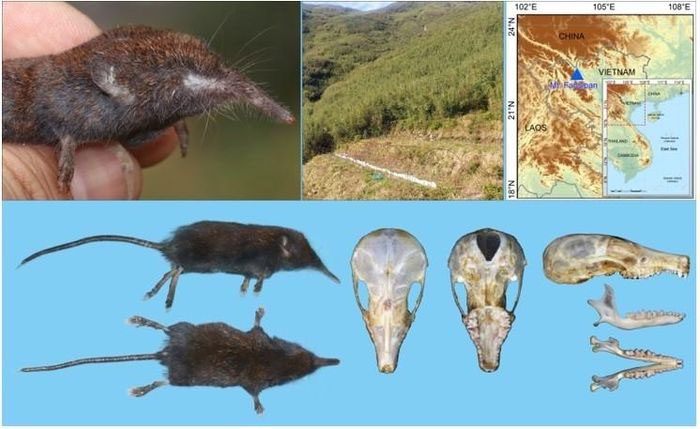Within the framework of cooperation between the Vietnam Academy of Science and Technology (VAST) and the Japan Society for the Promotion of Science (JSPS), scientists from the Gene Research Institute (VAST) and the Kyoto University Museum (Kyoto University, Japan) have discovered a new species of mole rat for science in Hoang Lien National Park.
According to Hoang Lien National Park, the results from sequencing the recombination activating genes (RAG1, RAG2) and mitochondrial gene (Cytb), totaling 2901 bp from two specimens collected at the summit of Fansipan, located within Hoang Lien National Park (Lao Cai Province) at an altitude of approximately 2900m, combined with analysis of 107 other sequences from the genebank, clearly show the branching of Uropsilus mole rat populations in Vietnam compared to populations in China.

External morphology, skull morphology, habitat, and distribution points of the Fansipan mole rat Uropsilus fansipanensis. (Photo: Provided by Hoang Lien National Park).
Comparison of Cytb gene sequences also revealed a difference of 8.63% to 20.70% between the population at Fansipan and eight previously published species of the same genus in China.
At the same time, the authors compared body morphology and skull morphology with various reference specimens preserved at the Natural History Museum in London, England.
Combining these analyses, the authors have announced a new species, the Fansipan mole rat (Uropsilus fansipanensis), for science.
This mole rat species is characterized by its elongated snout resembling a trunk; dark reddish-brown fur on its back, gray fur on its belly; a solid gray tail with white scales at the base; and possesses 38 teeth, with the lower jaw front teeth 1 and 3 being of similar size.
The Vietnam Academy of Science and Technology also noted that this is the first record of the Uropsilus genus in Vietnam, extending the distribution of this group of mammals southward compared to species recorded in China and Myanmar, into the Hoang Lien Son range of Vietnam.
This discovery, in addition to adding one genus and one new species to the Vietnamese mammal fauna, also highlights the close relationship in biodiversity between the northern mountainous region of Vietnam and southern China.
Previously, the Vietnam Natural Museum dispatched a working group to Hoang Lien National Park to investigate, collect, and study the diversity of insect species.
Experts from Japan participated in this working group, and the Hoang Lien National Park sent specialists from the Science and International Cooperation Department to assist in the fieldwork, guide, and collaborate with the team.
The working group carried out their activities in accordance with the permissions granted by the Lao Cai Provincial People’s Committee, ensuring no impact on nature conservation efforts and other activities of Hoang Lien National Park.
At the conclusion of the research period, the team documented 13 butterfly species belonging to the Order Lepidoptera at the survey sites.
- China accidentally discovers “gold mine hidden under the deep sea”: Massive reserves could sustain 1.4 billion people
- Strange exoplanet discovered, only as large as Neptune but with a density greater than steel
- Most valuable old photos from the late Qing Dynasty: The Forbidden City and the lives of the people vividly depicted


















































